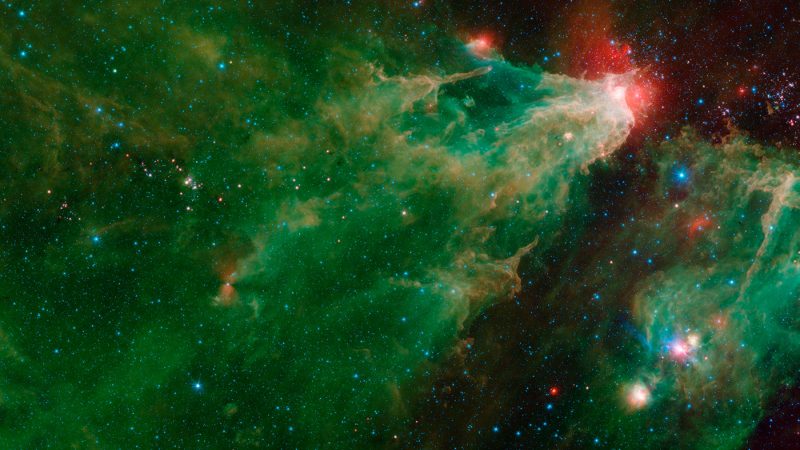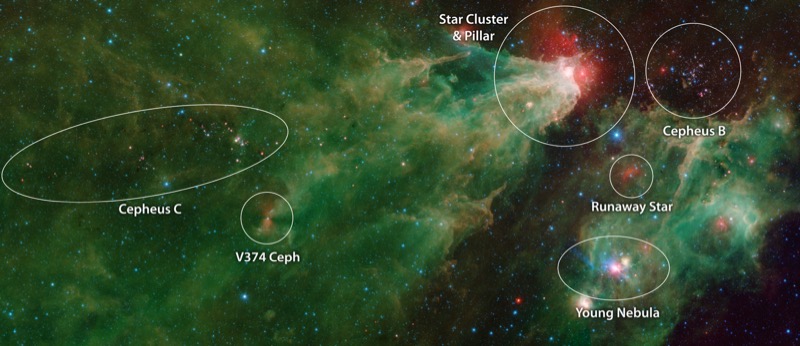
The video above offers some explanation of the large mosaic image below. You’ll want the explanation, because there’s a lot to see in this image taken by NASA’s Spitzer Space Telescope. Essentially, you’re looking at multiple clusters of stars – born from the same dense clumps of gas and dust – in the direction of the constellation Cepheus the King, located in the northern sky. Astronomers call this region the Cepheus C and B region. Some of these clusters here are older, and some are younger, and some are middle-aged.
So the mosaic is, in a sense, a family portrait of stars, featuring infants, parents and grandparents of a star-forming region, that is, a region of dense clouds of gas and dust in space.

View larger. | NASA’s Spitzer Space Telescope acquired the images to create this composite, before the spacecraft’s liquid helium coolant ran out in 2009. The green-and-orange delta filling most of this image is the Cepheus B and C region – a nebula – or celestial cloud of gas and dust. For details, see the video above or annotated image below. Image via NASA.
NASA wrote:
The grand green-and-orange delta filling most of the image is a faraway nebula, or a cloud of gas and dust in space. Though the cloud may appear to flow from the bright white spot at its tip, it is actually what remains of a much larger cloud that has been carved away by radiation from stars. The bright region is illuminated by massive stars, belonging to a cluster that extends above the white spot. The white color is the combination of four colors (blue, green, orange and red), each representing a different wavelength of infrared light, which is invisible to human eyes. Dust that has been heated by the stars’ radiation creates the surrounding red glow.
On the left side of this image, a dark filament runs horizontally through the green cloud. A smattering of baby stars (the red and yellow dots) appear inside it. Known as Cepheus C, the area is a particularly dense concentration of gas and dust where infant stars form. The dark vein of material will eventually be dispersed by strong winds produced as the stars get older, as well as when they eventually explode and die. This will create an illuminated puffed-up region that will look similar to the bright red-and-white region on the large nebula’s upper-right side. The region is called Cepheus C because it lies in the constellation Cepheus, which can be found near the constellation Cassiopeia. Cepheus C is about six light-years long and lies about 40 light-years from the bright spot at the tip of the nebula.
A second large nebula can be seen on the right side of the image, with a star cluster located just above it. Known as Cepheus B, the cluster sits within a few thousand light-years of our sun. A study of this region using Spitzer data found that the dramatic collection is about 4 million to 5 million years old – slightly older than those in Cepheus C.
Here’s the same image as above, annotated:

View larger. | An annotated mosaic of the Cepheus C and Cepheus B regions, by NASA’s Spitzer Space Telescope. Read more about this image.
NASA wrote:
The mosaic is a veritable family portrait, featuring infants, parents and grandparents of star-forming regions: Stars form in dense clouds of material, like the dark vein that makes up Cepheus C. As the stars grow, they produce winds that blow the gas and dust outward, to form beautiful, illuminated nebulas like the bright white spot at the top of the larger nebula. Finally, the dust and gas disperse, and the star clusters stand alone in space, as with Cepheus B.
The amazing features in this image don’t end there.
Look closely for the small, red hourglass shape just below Cepheus C. This is V374 Ceph. Astronomers studying this massive star have speculated that it might be surrounded by a nearly edge-on disk of dark, dusty material. The dark cones extending to the right and left of the star are a shadow of that disk.
The smaller nebula on the right side of the image includes two particularly interesting objects. In the upper-left portion of the nebula, try to find a blue star crowned by a small, red arc of light. This “runaway star” is plowing through the gas and dust at a rapid clip, creating a shock wave, or “bow shock,” in front of itself.
Also hidden within this second nebula, a small cluster of newborn stars illuminates the dense cloud of gas and dust where they formed. This feature appears as a bright teal splash.
Bottom line: Spectacular mosaic of the Cepheus B and C star-forming region, explained by NASA.
Via NASA’s Spitzer Space Telescope
from EarthSky http://bit.ly/2HZNn5s

The video above offers some explanation of the large mosaic image below. You’ll want the explanation, because there’s a lot to see in this image taken by NASA’s Spitzer Space Telescope. Essentially, you’re looking at multiple clusters of stars – born from the same dense clumps of gas and dust – in the direction of the constellation Cepheus the King, located in the northern sky. Astronomers call this region the Cepheus C and B region. Some of these clusters here are older, and some are younger, and some are middle-aged.
So the mosaic is, in a sense, a family portrait of stars, featuring infants, parents and grandparents of a star-forming region, that is, a region of dense clouds of gas and dust in space.

View larger. | NASA’s Spitzer Space Telescope acquired the images to create this composite, before the spacecraft’s liquid helium coolant ran out in 2009. The green-and-orange delta filling most of this image is the Cepheus B and C region – a nebula – or celestial cloud of gas and dust. For details, see the video above or annotated image below. Image via NASA.
NASA wrote:
The grand green-and-orange delta filling most of the image is a faraway nebula, or a cloud of gas and dust in space. Though the cloud may appear to flow from the bright white spot at its tip, it is actually what remains of a much larger cloud that has been carved away by radiation from stars. The bright region is illuminated by massive stars, belonging to a cluster that extends above the white spot. The white color is the combination of four colors (blue, green, orange and red), each representing a different wavelength of infrared light, which is invisible to human eyes. Dust that has been heated by the stars’ radiation creates the surrounding red glow.
On the left side of this image, a dark filament runs horizontally through the green cloud. A smattering of baby stars (the red and yellow dots) appear inside it. Known as Cepheus C, the area is a particularly dense concentration of gas and dust where infant stars form. The dark vein of material will eventually be dispersed by strong winds produced as the stars get older, as well as when they eventually explode and die. This will create an illuminated puffed-up region that will look similar to the bright red-and-white region on the large nebula’s upper-right side. The region is called Cepheus C because it lies in the constellation Cepheus, which can be found near the constellation Cassiopeia. Cepheus C is about six light-years long and lies about 40 light-years from the bright spot at the tip of the nebula.
A second large nebula can be seen on the right side of the image, with a star cluster located just above it. Known as Cepheus B, the cluster sits within a few thousand light-years of our sun. A study of this region using Spitzer data found that the dramatic collection is about 4 million to 5 million years old – slightly older than those in Cepheus C.
Here’s the same image as above, annotated:

View larger. | An annotated mosaic of the Cepheus C and Cepheus B regions, by NASA’s Spitzer Space Telescope. Read more about this image.
NASA wrote:
The mosaic is a veritable family portrait, featuring infants, parents and grandparents of star-forming regions: Stars form in dense clouds of material, like the dark vein that makes up Cepheus C. As the stars grow, they produce winds that blow the gas and dust outward, to form beautiful, illuminated nebulas like the bright white spot at the top of the larger nebula. Finally, the dust and gas disperse, and the star clusters stand alone in space, as with Cepheus B.
The amazing features in this image don’t end there.
Look closely for the small, red hourglass shape just below Cepheus C. This is V374 Ceph. Astronomers studying this massive star have speculated that it might be surrounded by a nearly edge-on disk of dark, dusty material. The dark cones extending to the right and left of the star are a shadow of that disk.
The smaller nebula on the right side of the image includes two particularly interesting objects. In the upper-left portion of the nebula, try to find a blue star crowned by a small, red arc of light. This “runaway star” is plowing through the gas and dust at a rapid clip, creating a shock wave, or “bow shock,” in front of itself.
Also hidden within this second nebula, a small cluster of newborn stars illuminates the dense cloud of gas and dust where they formed. This feature appears as a bright teal splash.
Bottom line: Spectacular mosaic of the Cepheus B and C star-forming region, explained by NASA.
Via NASA’s Spitzer Space Telescope
from EarthSky http://bit.ly/2HZNn5s

Aucun commentaire:
Enregistrer un commentaire